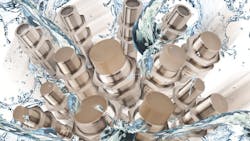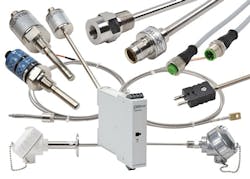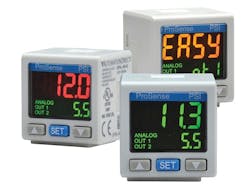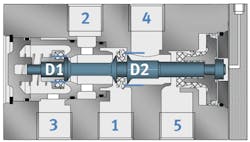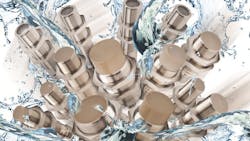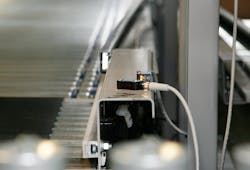A Primer on Sensors for Machine Automation
Machines need sensors and transmitters to operate reliably and consistently. All it takes is a small drop in air pressure or a slight jam to cause a machine to crash; these sorts of problems can often be detected before they lead to bigger issues.
Here’s a look at the top 10 physical properties detected by machine automation sensors and transmitters—temperature, pressure, flow, level, current, voltage, presence, position, distance and speed—and one or more common applications for each property.
How Hot is It?
In machine automation, monitoring and controlling temperature is often essential, and there are many temperature switches or transmitters that can make these measurements. Temperature switches work well in overtemperature, set and reset hysteresis, and dual-temperature high and high-high temperature applications. In these last two types of applications, temperature measurement methods provide increased reliability where exceeding a temperature must be avoided, such as in boilers, compressors and large motors. Switches are also suitable for simple temperature control.
For more complex temperature monitoring and control, thermocouples and RTDs connected to temperature transmitters provide more granular feedback to close the control loop.
Thermocouples are good choices for measuring temperature, especially if the distance from the thermocouple to the controller is less than 100 ft. Thermocouples come in a wide variety of types, fit into small areas, have wide temperature ranges and provide fast responses.
However, temperature sensors’ millivolt signals are sensitive to electrical noise, require matching extension wires and are not as linear or accurate as two-, three- or four-wire RTDs. The millivolt signals are also not scaled, so the PLC must do this calculation.
When distance and electrical noise are a concern, temperature transmitters should connect the thermocouples to the PLCs.
Temperature transmitters convert millivolt input signals from thermocouples or RTDs to 4 to 20mA analog outputs or digital fieldbus signals. Temperature transmitters are commonly used in machine processes, tanks and ovens. Their scaled analog outputs ease integration to PLCs and simplify calibration with their pre-configured temperature ranges and other configuration capabilities.
Under Pressure
Every machine with a pneumatic air preparation subsystem should have a digital pressure switch, preferably with a display to show its status. The switch sends its output to the PLC, which is essential because it needs to know there is enough air pressure available before starting a cycle. Some machines work well at 60 psig, while others require 90 psig to meet cycle time requirements. This makes an adjustable range and lockable keypad important features for pressure switches.
A discrete signal from a digital pressure switch typically tells the PLC the pressure is sufficient. If more information is required, there are devices to provide both discrete and analog outputs, as well as local indication of pressure. These devices provide pressure values with reasonable accuracy, and often include air/gas process control options.
Some pressure switches can be set locally using mechanical dials or hex keys to set the pressure level at which they will activate. Pressure switches with set and reset adjustments can provide simple control with hysteresis for a compressor or pump. Pressure switches can also provide overpressure or pressure-sufficient signals in pneumatic and engine monitoring systems, presses and machine tools.
If more granular pressure indications are needed, pressure transmitters can generate readings over a wide range. Pressure transmitters can also detect leaks or gas, as well as monitor compressors or the vacuum levels in suction cups that are part of pick-and-place devices.
Some applications require differential pressure transmitters to measure low positive, negative and bi-directional differential pressures. These include monitors for HVAC duct static pressure or air filters, building or chamber pressurization, clean rooms, fume hoods, air flow measurement and draft pressures in furnaces, ovens and dryers.
Check the Flow
Flow indicators are often used to confirm flow of a gas or liquid using a paddle wheel or floating ball. Flow switches typically use spring-supported pistons lifted by a flowing medium, with the piston position detected by an inductive sensor. The spring lets these devices, which can also be used as check valves, be mounted horizontally or vertically.
Flow switches usually provide fast responses and precise, adjustable set points. The set point can be easily specified and locked with a setting screw or rotating dial to simplify machine setup.
A simple, discrete indication of flow is often needed for machine tool coolant, HVAC, and cooling water monitoring for processes such as injection molding. In these applications, the flow must be present and above a set point, but the actual flow is not monitored. When actual flow needs to be monitored, a flow transmitter is used.
In these applications, flow transmitters can monitor liquid media and provide analog or digital fieldbus outputs proportional to flow rates. There are many different ways to measure flow, but flow sensing based on differential pressure ensures fast response times and precise measurements.
Don’t Overfill
Float level switches are low-cost, general-purpose devices for single-point monitoring of liquid levels in a variety of applications. They are available made from materials compatible with many types of liquids, a wide temperature range, and various pressure capabilities. They can be top- or side-mounted, and submerged or suspended. These mounting options, along with shock and vibration resistance, ensure reliable operation.
Discrete tank level indication is a popular application. If a tank has threaded ports at low-, full-, and high-level positions, float switches are a simple way to determine when a liquid reaches each of these three measurement points. A level switch can also be used as a backup up or safety level sensor to detect high-high overflow levels, and works well in pump monitoring to detect when there is enough liquid at a pump intake to prevent cavitation.
If actual tank level needs to be measured or monitored, level transmitters are required. Some level transmitters are submersible and continuously measure liquid levels by sensing hydrostatic pressures created by the weight of liquid—and hence, its height above the sensor—which then sends a 4 to 20 mA or digital fieldbus output signal. In addition to monitoring liquid levels, these transmitters work well in dewatering applications, in addition to controlling pumps and slurry tank liquid levels. For non-contact applications, such as measuring the level of a glue pot or tank full of paint, ultrasonic level transmitters can handle the task.
Current’s Flowing
A current switch consists of a current transformer or Hall Effect sensor, signal conditioner, and limit alarm in a single package. An ac or dc current switch provides proof of operation via its discrete output, and can also provide an accurate and dependable indication of overcurrent conditions.
AC current switches can detect jams or overloads on conveyors. They also work well detecting the on/off status of lighting and heating circuits. A dc current switch, on the other hand, can monitor welder status, power-supply overcurrents, and battery pack readiness.
A current transmitter extends the capability of a current switch by measuring an actual ac current, true RMS current, or dc current. Specific applications for true RMS current transmitters include monitoring VFD controlled loads and accurately measuring phase angle- or burst-fired, time-proportioned SCR controlled loads. True RMS current measurement can also accurately measure power supply or ballast input power.
DC current transmitters can work in many applications, including monitoring battery bank charging and load current and heater loads.
Power On
In some applications, voltage switches using simple resistor-based voltage divider circuits to sense voltages at PLC inputs are a good choice. Voltage transmitters work well when there is a need to sense an ac or dc voltage and provide a proportional 4 to 20mA analog or digital fieldbus output to a PLC.
There is a lot of overlap in ac and dc voltage transmitter applications, such as detecting below normal or brownout voltage conditions to prevent overheating motors. In ac systems, switches or transmitters identify phase-loss conditions by detecting lower or missing voltage in one or more phases of a three-phase motor circuit. Both ac and dc voltage transducers can look for overvoltages associated with regenerative systems to identify and avoid issues with the motor drive or detect voltage conditions that may stress or damage devices.
Presence Sensing
A variety of sensors detect parts on machines or conveyor lines, and there is a lot of commonality in these presence sensors for different applications. Common presence sensors include photoelectric, inductive, capacitive and ultrasonic versions. There are some key factors to consider, as one type of sensor may work better than others in an application.
Photoelectric sensors probably have the widest range of applications, including detecting pallets on conveyors and parts’ presence in a nest. They have significant capabilities in detecting parts, products and even marks on printed material. Many of them also have long-range capabilities and can detect small positional changes.
Inductive sensors, or inductive proximity switches, detect metal objects at close ranges (up to 1.5 in., typically). Ferrous metals have the longest detection ranges, but aluminum and copper can also be detected at ranges of about 1 in. reduced ranges. Common applications include sensing actuator end-of-travel and detecting metal parts. Inductive proximity switches’ low costs make them the best choice for sensing an actuator at its extended, retracted or home position, and detecting pallets or metal.
Capacitive sensors can see through cardboard, plastic and paper and be used to detect liquid. With adjustments, they also detect parts submerged in a liquid. Depending on how they are adjusted, capacitive sensors can also detect liquids such as oil, water and chemicals, as well as with solids like sand, grains and powders. They also see through tank walls and opaque bottles to detect fill levels.
Ultrasonic proximity sensors emit sound impulses, measure the elapsed times for the echoes to return, and then determine the distance of the reflecting target from the sensor. Ultrasonic sensors detect a wide range of materials, including metal, wood, plastic, glass and liquids. They are not affected by object color, transparency or reflectance.
Other sensors to consider include contrast print-mark sensors for packaging lines, beverage and bottling lines, paper and printing machinery, and ceramics printing. Another is a U-shaped through-beam fork sensor (slot sensor) that mechanically aligns the transmitter and receiver to simplify installation. And finally, magnetic proximity sensors that detect magnet targets may work for other applications.
Getting in Position
There are several ways to detect positon, often with presence sensors, as already discussed. For sensing part positions, a photoelectric sensor with accompanying software can tell if a part is fully seated. It detects small changes in position and can be mounted to confirm a position.
Inductive proximity switches or capacitive sensors are commonly used to detect actuator positions. However, accurate position sensing over a full range of travel requires an encoder or sometimes a more rugged resolver.
Encoders, sometimes connected to transmitters, are the preferred method of detecting linear and rotary positions—in addition to velocity and direction—of a motor shaft or other rotating component or assembly. They work in all types of motion sensing applications, including machine tooling, semiconductor positioning and multi-axis positioning.
Incremental encoders measure positions relative to a start position (and may require a “homing” routine, depending on the application), while absolute encoders are referenced to a fixed position, and “know” their position at all times, including when powering up.
For linear applications, encoders attach to a motor, rotary shaft or surface-driven wheel and generate a pulse train output in a variety of signal configurations. In some high-accuracy applications, a linear encoder, which includes a scale and sensor, converts the linear scale position into an analog or a fieldbus signal.
Detecting Distance
Programmable photoelectric sensors can determine rough distances and so act as a “within range” detector. Programmable functions in the sensor let it detect targets at an approximate distance.
Some photoelectric sensors also serve as distance transmitters, outputting a 0 to 10 Vdc signal to indicate a measurement range or distance. A class 1 or 2 laser is needed in diffuse and retro-reflective (transit time) laser-based distance sensors. These transmitters can detect distances ranging from 5 mm or less to 10 m or more. With short-range laser distance sensors, resolutions are less than 8 µm. At distances over 10 m, resolution is not as good, but still enough for most machine automation purposes.
Applications for photoelectric distance sensors include determining if a part is seated in a fixture and measuring part height, diameter or thickness. In longer-range applications, they can measure gantry position, or the droop in a web of material in an accumulator.
Speed Sensing
Encoders and resolvers are readily available for sensing speed and position. Speed detection and zero-speed sensing can be added to most rotating shafts using either a Hall Effect, inductive or photoelectric sensor. The sensor is able to see ferrous gears and sprockets with many teeth or holes, or detect a single magnet or target once per revolution. Sensor output is typically a digital pulse train suitable for monitoring via a PLC’s high-speed counter input.
Speed switches are widely used in machine automation to monitor rotating shafts where turning too quickly or slowly damages the machine or creates process problems. Stopping machines if they run too fast is a common use. Safety-rated zero-speed switches are important in machine safety applications where all components must be stopped before removing power for a safe shutdown.
Digital-to-analog converters can change speed pulses into a current or voltage output that can be read by an analog PLC input. This value can then be used to close the loop for applications where precise control of motor speed is essential.
There are an abundant number of types and versions of switches and transmitters for measuring a wide range of physical properties in machine automation applications. Wiring their discrete, analog or digital fieldbus outputs to PLC inputs helps bring a machine to life by providing it with continuous operating information.
There is significant overlap between switches and transmitters, but in general switches should be used if they meet the application requirements because they are simpler, less expensive, and smaller than transmitters. They are also less expensive to connect to PLCs, requiring only a discrete input as opposed to an analog or fieldbus input. Transmitters are available for more complex applications, and can be used to solve a wide variety of measurement problems and to close control loops.
Sensor or Transmitter: What’s the Difference?
People involved in the machine automation industry commonly use the terms “sensor” and “transmitter” interchangeably. In this article, a sensor or switch is a device measuring or detecting a discrete, on-off condition. Position, temperature and pressure switches are examples. Transmitters, on the other hand, measure continuous values and convert them proportionally to a common electrical signal level such as 4 to 20 mA, 0 to 10Vdc, or a digital fieldbus signal.
Transmitters are typically analog output devices (such as a temperature transmitter with a 4 to 20mA output), although pulse counting (e.g., reading and sending the speed of a motor) might be done using discrete signals, analog signals, or a combination of the two. Sensors with fieldbus outputs represent a third case, where analog information is captured and then transmitted in a digital form.
These sensors or transmitters connect to PLCs, data loggers, HMIs, SCADA systems, and/or the IIoT. In machine automation, sensor and transmitter outputs typically become discrete and analog inputs, respectively, to a PLC.
Download this article in .PDF format
This file type includes high resolution graphics and schematics when applicable.
Editor's Note: This article was updated on Jan. 31, 2025.
